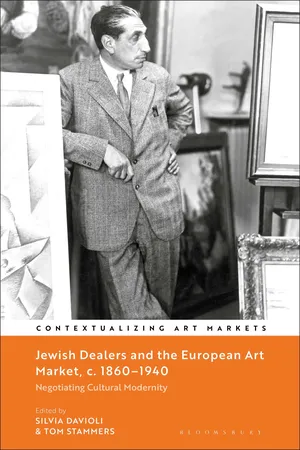
Jewish Dealers and the European Art Market, c. 1860–1940
Negotiating Cultural Modernity
- 345 pages
- English
- PDF
- Available on iOS & Android
Jewish Dealers and the European Art Market, c. 1860–1940
Negotiating Cultural Modernity
About this book
Before the tragedy of the Holocaust, many of the leading art and antiques dealers across Europe were Jewish, establishing dynamic cross-Channel, international and transatlantic networks. Aside from a few famous examples, however, we are only at the beginning of exploring the diversity of Jewish dealers' commercial and cultural worlds, and reflecting on the particular conditions that made possible their dramatic expansion within the profession. Adopting a wider geography than any previous study, this book brings together a team of distinguished international contributors to consider Jewish art dealers as an interconnected cohort, tied together by common strategies and a shared vulnerability. After an extended historiographical introduction, the volume presents case studies and trends from 1860-1940, including: Jewish family businesses in Western Europe; the role of Jews as mediators of art from East Asia; the antisemitism and suspicion faced by Jewish dealers; Jews as theorists, exhibition makers and promoters of modern art; and the geographical mobility and professional reinvention of Jewish dealers in times of economic and political crisis. With a wide variety of illustrations, including paintings, decorative arts, historic photographs and archival material, the volume adopts a mix of methodological approaches to analyse a key chapter in Jewish cultural history and in the history of the international art market. Includes Afterword by Charles Dellheim, author of Belonging and Betrayal: How Jews Made the Art World Modern (2021).
Frequently asked questions
- Essential is ideal for learners and professionals who enjoy exploring a wide range of subjects. Access the Essential Library with 800,000+ trusted titles and best-sellers across business, personal growth, and the humanities. Includes unlimited reading time and Standard Read Aloud voice.
- Complete: Perfect for advanced learners and researchers needing full, unrestricted access. Unlock 1.4M+ books across hundreds of subjects, including academic and specialized titles. The Complete Plan also includes advanced features like Premium Read Aloud and Research Assistant.
Please note we cannot support devices running on iOS 13 and Android 7 or earlier. Learn more about using the app.
Information
Table of contents
- Cover
- Halftitle page
- Contextualizing Art Markets
- Published Books in the Series
- Title page
- Copyright page
- CONTENTS
- PLATES
- FIGURES
- NOTES ON CONTRIBUTORS
- ACKNOWLEDGEMENTS
- A NOTE ON THE COVER
- SERIES EDITOR’S INTRODUCTION
- Introduction – Negotiating Cultural Modernity: An Introduction to Jewish Art and Antiques Dealers 1860–1940
- 1 Art Dealing in ‘the Hands of Abraham’s Posterity’: Jewish Art Dealers in Victorian London
- 2 Moisè Michelangelo Guggenheim (1837–1914) in Venice: Dealer, Manufacturer, Decorator, Collector and Philanthropist
- 3 Mannheim, Father and Son ,in Paris (1817–1910): From German-Jewish Immigrant to Leaders of the Art market
- 4 ‘The Only Man in Europe’: Charles Davis (1849–1914), an Anglo-Jewish Dealer, and the Commercial Cousinhood
- 5 The Samuel Family as Dealersin East Asian Art and Curios, 1878–1926
- 6 Florine Ebstein Langweil: Jewish Networks in the East Asian Art Trade
- 7 Antisemitism and the Jewish Art Dealer: The Case of Siegfried Bing and Julius Meier-Graefe
- 8 Exterminating Cubism: Bochisme, L’Art Juifand the Vilification of Daniel-Henry Kahnweiler (1884–1979)
- 9 Léonce Rosenberg’s Cubism: Jewish Mediterraneanism and the Question of Assimilation
- 10 Alfred Flechtheim and the Flechtheim Galleries, 1913–331
- 11 A Parisian in London, and New York: Genesis of a Modern Art Dynasty – Gimpel Fils
- 12 Conflicted Modernisms: Martin Birnbaum’s Transnational Exhibitions, 1910–26
- 13 Rags to Riches: Becoming Leo Nardus
- 14 The Mysterious Birtchansky Brothers: Moscow–Paris–The French Riviera
- Afterword: Why the Jews?
- INDEX
- Plates